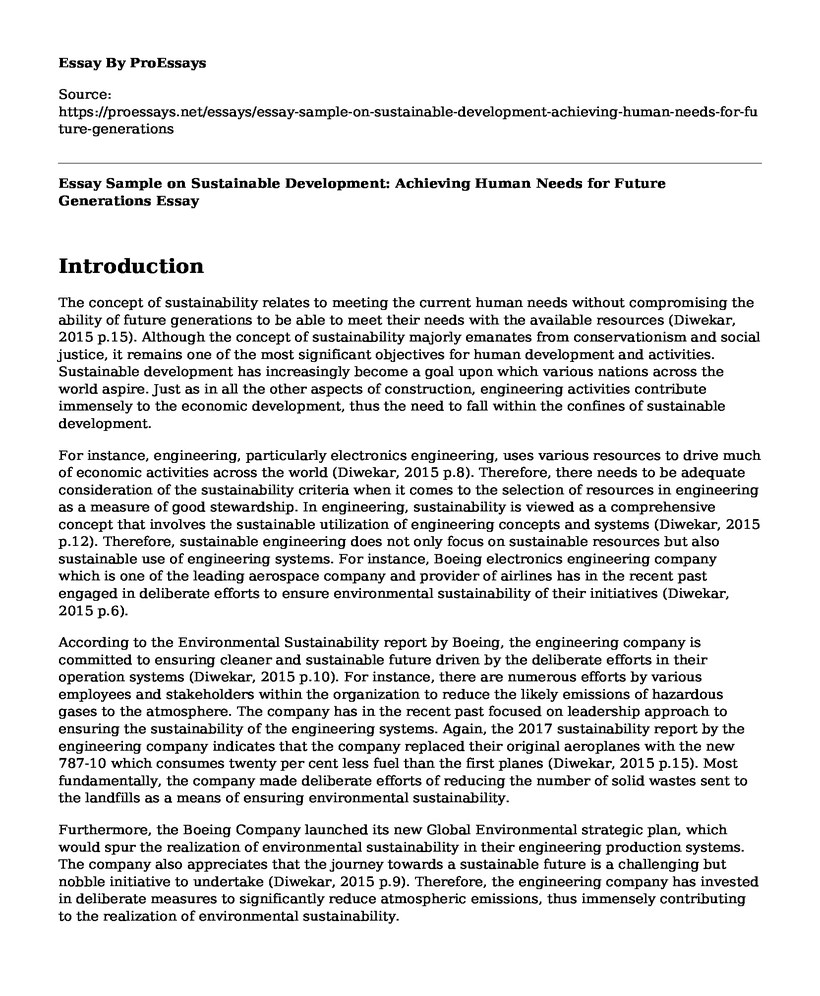Introduction
The concept of sustainability relates to meeting the current human needs without compromising the ability of future generations to be able to meet their needs with the available resources (Diwekar, 2015 p.15). Although the concept of sustainability majorly emanates from conservationism and social justice, it remains one of the most significant objectives for human development and activities. Sustainable development has increasingly become a goal upon which various nations across the world aspire. Just as in all the other aspects of construction, engineering activities contribute immensely to the economic development, thus the need to fall within the confines of sustainable development.
For instance, engineering, particularly electronics engineering, uses various resources to drive much of economic activities across the world (Diwekar, 2015 p.8). Therefore, there needs to be adequate consideration of the sustainability criteria when it comes to the selection of resources in engineering as a measure of good stewardship. In engineering, sustainability is viewed as a comprehensive concept that involves the sustainable utilization of engineering concepts and systems (Diwekar, 2015 p.12). Therefore, sustainable engineering does not only focus on sustainable resources but also sustainable use of engineering systems. For instance, Boeing electronics engineering company which is one of the leading aerospace company and provider of airlines has in the recent past engaged in deliberate efforts to ensure environmental sustainability of their initiatives (Diwekar, 2015 p.6).
According to the Environmental Sustainability report by Boeing, the engineering company is committed to ensuring cleaner and sustainable future driven by the deliberate efforts in their operation systems (Diwekar, 2015 p.10). For instance, there are numerous efforts by various employees and stakeholders within the organization to reduce the likely emissions of hazardous gases to the atmosphere. The company has in the recent past focused on leadership approach to ensuring the sustainability of the engineering systems. Again, the 2017 sustainability report by the engineering company indicates that the company replaced their original aeroplanes with the new 787-10 which consumes twenty per cent less fuel than the first planes (Diwekar, 2015 p.15). Most fundamentally, the company made deliberate efforts of reducing the number of solid wastes sent to the landfills as a means of ensuring environmental sustainability.
Furthermore, the Boeing Company launched its new Global Environmental strategic plan, which would spur the realization of environmental sustainability in their engineering production systems. The company also appreciates that the journey towards a sustainable future is a challenging but nobble initiative to undertake (Diwekar, 2015 p.9). Therefore, the engineering company has invested in deliberate measures to significantly reduce atmospheric emissions, thus immensely contributing to the realization of environmental sustainability.
Concisely, Boing has also partnered with Etihad Airways in flying the 787 Dreamliner- an aeroplane that is partly empowered by biofuels which are generated from the desert plants that are grown from irrigation with the seawater. The company has also partnered with various recyclers based in the United Kingdom to keep almost 2 million of carbon fibres which are excess from Boeing factories from entering the landfills annually (Diwekar, 2015 p.13).
Conclusion
In conclusion, since sustainability cuts across socio-economic and environmental realms, engaging in more sustainable initiatives within the engineering and business companies improves overall economic output and as well as desirable ecological conditions. All companies, including engineering organizations, should make deliberate efforts and initiatives geared towards ensuring socio-economic and environmental sustainability in all operations. Such actions should include reduced emissions and solid waste generation to the environment, among others. However, it should be noted that engineering sustainability should be viewed more under the lenses of systems change rather than resource sustainability.
References
Diwekar, U., 2015. Engineering sustainability. In Assessing and measuring environmental impact and sustainability (pp. 1-24). Butterworth-Heinemann. Retrieved from https://doi.org/10.1016/B978-0-12-799968-5.00001-4
Cite this page
Essay Sample on Sustainable Development: Achieving Human Needs for Future Generations. (2023, Mar 04). Retrieved from https://proessays.net/essays/essay-sample-on-sustainable-development-achieving-human-needs-for-future-generations
If you are the original author of this essay and no longer wish to have it published on the ProEssays website, please click below to request its removal:
- Operations and Information Management - Essay Example
- Ethics on the Position Essay Example
- Questions and Answers on Mobility - Paper Example
- Project Proposal for Increase the Profits and Augment the Product Portfolio of the Seamus Company
- Research Paper on Disney's Low-Cost Integrated Differentiation Strategy
- Essay Example on Contract File Management: Uncovering Significant Vulnerabilities
- Paper on Agile at Scale: Revolutionizing Leadership and Supply Chain Management for Business Excellence







